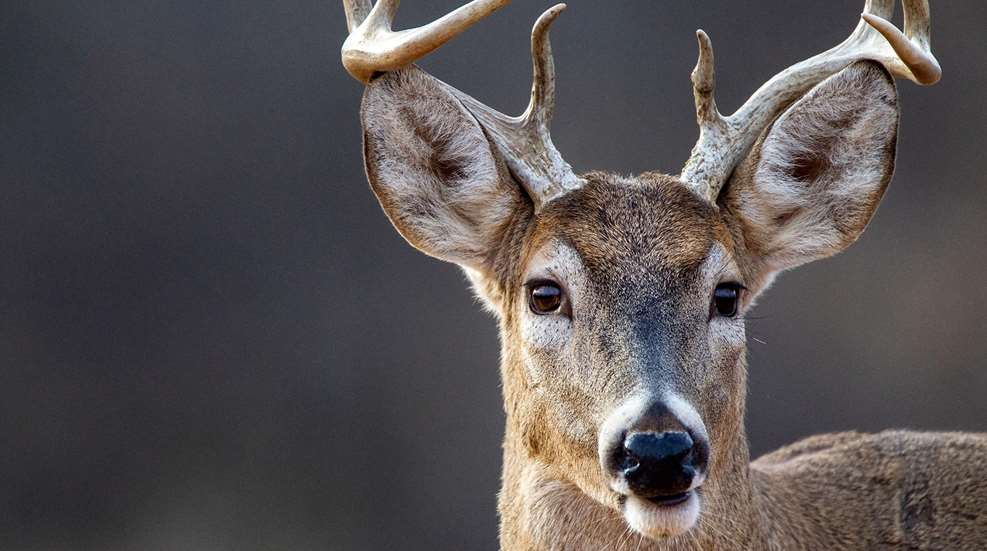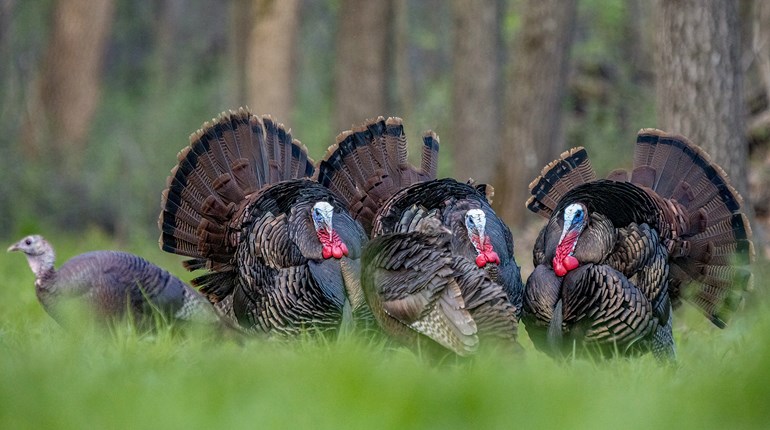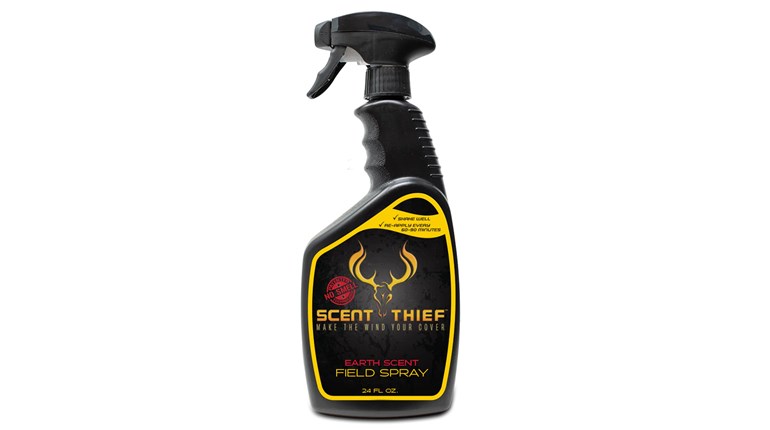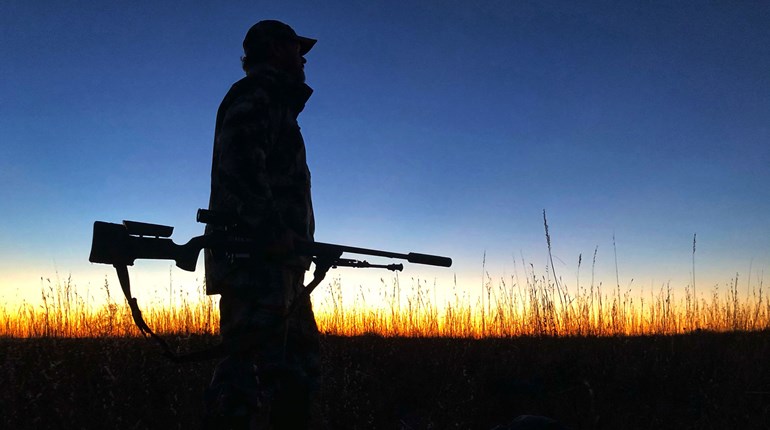
Resting on a cliff edge after a morning of elk hunting and digging through my backpack for a feral energy bar that had strayed from my food stash does not seem fitting for the start of a whitetail article. However, the Morse code notification ding on my smartphone ties the two together.
As I read the text from my hunting buddy Levi Duncan, I just shook my head, thinking, “That figures.” His text confirmed the trickles of information already whispered in the swath of South Dakota where my future whitetail hunt was set. Epizootic hemorrhagic disease, EHD for short, was worse than he thought. His ranch, and much of western South Dakota, northeast Wyoming and southeast Montana, all were in the bullseye of a major outbreak. South Dakota even put out an offer to refund deer licenses. That unpleasant newsflash, combined with an elk hunt proceeding without the participation of elk, had me thinking the fall hunting season might be a dud.
 Kayser is no stranger to EHD. He often finds dead bucks in the spring while shed antler hunting in the mountains near his Wyoming home.
Kayser is no stranger to EHD. He often finds dead bucks in the spring while shed antler hunting in the mountains near his Wyoming home.
As I devoured the discovered energy bar, my smartphone dinged again. Levi shined some hope with a message in which he said I should keep the tag. He felt confident the event was not a total wipeout. He would stay on the hunt for a buck to maintain my license investment, so I felt the odds were good with him on the case. They were likely higher than my current situation staring at beautiful country devoid of elk.
The Culprit
EHD has earned more respect in recent years despite clawing its way through a saturated advertising campaign centered on chronic wasting disease.
Do not read me wrong—CWD projections should bring alarm. First detected along the Front Range of Colorado in 1967, CWD now has spread across 30 states and five Canadian provinces to all family Cervidae populations: deer, elk and moose. There is no cure, it is not treatable and, after infection, the diagnosis is fatal. Infection rates vary from more than 10 percent to beyond 40 percent in herds with little active management according to the CWD Information website. An interesting five-year study from the University of Wyoming, ground zero for major outbreaks, notes CWD is killing 19 percent of the deer herd annually. According to the study, at that rate an entire population of deer could “go virtually extinct in 41 years.”
That is unlikely to happen due to deer dispersion and possible genetic resistance, but you can see why wildlife managers look at CWD with seriousness. Fortunately, there is no evidence of the wasting disease spreading to humans. Even so, never eat an infected animal and consider testing it before putting it in your freezer.
Like CWD, EHD affects whitetails through a large swath of country, primarily the central section of the country, but never say “never.” Interestingly, it basically affects whitetails with some pronghorn, elk, bighorn sheep and mule deer outbreaks occurring less frequently. And whereas CWD has a fairly predictable rate, EHD has a history of showing up sporadically, nearly every year in small events after the first documented case in 1955.
Small events aside, the major events require you to keep up your guard. In some years, you can expect a 50 percent or more die-off during an outbreak—and there is a history of wiping out nearly an entire herd in pandemic-like waves. COVID-19 continues to snatch national headlines, but for my upcoming deer hunt EHD took center stage, leaving a swath of destruction in the Great Plains and foothills of the West.
Spread by a tiny, two-winged midge, EHD kills infected animals within days. Infected animals develop a high fever and hemorrhage internally. Hunters routinely find carcasses near water as the dead invariably include sick animals seeking water for fever relief to try to replenish blood loss. Once a killing frost occurs, insects diminish and so does the disease … until another possible outbreak the following summer. Like CWD, no cure exists for EHD, although some private wildlife managers now spray for insects to try to control the midge outbreak. Because EHD acts fiercely fast, it is doubtful you would shoot an infected animal. Regardless, hunters should report any suspected cases of sick-looking deer and find resources to test questionable animals before consuming them.
An EHD Hunting Strategy
As the time for my hunt with Levi neared, his confidence showed signs of cracking. Between texts and phone calls, I could feel the earlier self-assurance replaced with timid skepticism. As I returned from a Kansas whitetail hunt, he sent me a message: “Found one!” The accompanying photo came from his family ranch and, although smartphone blurry, it distinctly showed a mature whitetail, above average mass with a tight, tall formation. I replied: “Perfect.” We settled on a hunt for the third week of November.
Levi’s lack of confidence had more than an EHD justification. Much of South Dakota had been pummeled by an extended drought. Crops failed, pastures could not support grazing and reservoirs dried up. Disaster assistance was widespread to aid farmers and ranchers affected by the persistent lack of rain. EHD, combined with the ongoing drought, scattered the remaining, resilient deer across a large swath of open country that gave deer a near insurmountable advantage for evasion in the land of “Little House on the Prairie.”
 Before the hunt rancher Levi Duncan sent the author this photo of a mature buck living on his land, raising hopes for a good hunt amid a break-out of EHD.
Before the hunt rancher Levi Duncan sent the author this photo of a mature buck living on his land, raising hopes for a good hunt amid a break-out of EHD.
In the days running up to the hunt we focused on the one living candidate and a strategy to hunt the main creek running through the buck’s homeland. But Levi expanded his search with drives throughout the area after checking cattle. It was during one of these forays he stumbled across a gold mine. Winds on that day were at Category 1 Hurricane levels as Levi passed a standing, dryland cornfield stunted by drought. He passed the cornfield routinely as it was on his way to check cattle, but on this day it was different. It was full of deer!
Whipping winds, corn carbohydrate energy and the lure of escape cover, however badly stunted, drove more than a hundred deer into the 320 acres of crappy corn. Plus, agricultural fields are rare in this land of pastures and cattle. Using quick detective work, Levi unearthed the owner and secured hunting permission. After being in the dumps for days about my arrival, Levi’s confidence swelled like a toddler smacking a tee-ball out of the yard for the first time.
Hunting standing corn may seem daunting, but not to me. I grew up in South Dakota’s corn country. I may live in Wyoming these days, but this would be a welcome homecoming. I killed my first four whitetails in standing corn, all with a bow. My dad did not hunt, but he did sell farm equipment and knew every farmer for miles around. That connection opened numerous fields for hunting—and most of them harbored corn. With nobody telling me that hunting in corn was next to impossible, I jumped in and turned into a cornfield ninja. Despite my best ninja moves, camouflaged with faded World War II camouflage to match the backdrop, cornfield hunting still required help from above—yes, God’s helper, Mother Nature. To successfully navigate into shooting range of deer in corn, particularly standing corn, you need a weather event to create noise chaos in the leaves. Wind, snow, drizzle—alone or combined—all help veil a ninja approach.
Today you can read the mind of Mother Nature with a quick glance at your hunting app. My HuntStand app provides a 72-hour preview of detailed weather events, but back in the day you had to tune in to top-of-the-hour news for clues. Fortunately, Levi lives in a wind tunnel of the Great Plains so gusty days were not something requiring prayer to experience.
On the first morning of the hunt, Levi dropped me at a set of corrals in the dark. The plan was for me to sneak to a creek observation point and look for the heavy-antlered deer he’d sighted on his ranch. He would watch a different corner of the property then get cattle chores completed after daybreak. If the morning plan did not produce, the forecast smiled on us for gusty winds to assault the stunted corn the last half of the day.
The morning proved informational, but not rewarding. Had I been mule deer or coyote hunting, the morning offered many opportunities. A tall-tined mule deer buck waddled by in its search for a harem of does to survey, and several coyotes darted through the creek bottom searching for a rodent brunch before naptime in the brush. Missing was the mature whitetail Levi had spotted on several occasions. When we regrouped later, Levi’s report also lacked a whitetail theme. So the afternoon assault on the cornfield was set.
Cornfield Ninja
Needing to attend to his job, Levi pointed me in the direction of the cornfield and, after witnessing more than 100 deer in it, wished me luck. Walking to the far corner for a downwind start into the corn, I was impressed that some of the corn stood head high. Plus, the rolling terrain allowed commanding views of the field and the surrounding prairie. Working my way into the middle of the field in concert with gusts of wind allowed me to reach a high point of stunted corn where I could see much of the field with my KILO3000 rangefinding binocular. I waited there for deer activity to kick off, and it did not take long for a young buck to rise nearby and start chasing does.
At least three young bucks hustled does in far corners of the field, but the 100 or more deer Levi spotted earlier were missing. Corn creates a cloaking system to hide deer, but from my observation point I knew a large population of the deer hunkered there for the earlier hurricane event were real estate hopping like a house flipper.

The following morning we stuck with the same plan: hunt the creek while Levi did reconnaissance between cattle chores. Although the mule deer seemed to have settled on the creek bottom as an ideal homestead, where several nice bucks courted does, the whitetails were again MIA. Winds, again, allowed for another incursion into the corn for the afternoon. Pacing myself, I did another slow, but meticulous scouting mission through the stalks while Levi checked out a pasture nearby—based on a hunch from years of living in prairie. My cornfield foray proved beyond doubt that the deer amassed earlier by hurricane winds had relocated.
As I regrouped with Levi later, I saw a glimmer of hope.
“I think the deer moved east to another picked field,” said Levi. “Right at dark I saw a string of deer leaving a deep creek bottom near the field, and I am guessing those are the deer I saw in the cornfield you have been hunting. Darn things just won’t stay still in this open country!”
Levi and I were thinking alike on the situation. EHD knocked the whitetail population into meager numbers and, combined with a stripped landscape from the drought, deer were rambling like a hobo from yesteryear. It made sense as they searched for breeding and feeding opportunities. We needed to do the same, minus the breeding, but definitely while packing a sack lunch.
Although most whitetails prefer living in a home territory, these deer were living more of an elk existence. Environmental conditions, combined with firearm season, prodded them to relocate for a safe haven. Maybe Levi finally found the deer refuge? Again, diligently punching the keys on his smartphone, he secured permission to hunt from a family friend.
Sunset Showdown
The following morning the floodgate opened on the prairie winds along with windchills near zero. Our numbness disappeared as deer, white-tailed deer, began moving at dawn. Hustling to a hilltop perch overlooking a creek, we quickly settled our sights on a decent 4x4 whitetail ambling our way. With the gusting winds, I opted to pass on the shot since others were busy rutting in the distance, and we set our sights on a mature buck with good features. With deer all around us, EHD and drought seemed like a situation of the past.
By the time we crawled to an adjacent ridge to assess the mature buck, he had moved on. November breeding was beginning to slow down; bucks wasted no time with a doe not emitting estrus signals. The whole morning, something had been bugging Levi, and late in the afternoon he let it spill.
“You know the mature buck we stalked just before noon that gave us the slip?” he asked. “I am sure that was the same buck I wanted you to shoot on our ranch—and guess what? It was.” Levi pointed behind us to a lone deer walking on the neighbor’s side of the fence. With spotting scope confirmation, there was no doubt it was the same buck as we compared pictures to the real thing. That buck had traveled more than 4 miles as the crow flies and likely a dozen or more in its meandering state of breeding inebriation.
 With a flexible plan of hunting cropland and prairie, the author was able to connect on a 5x5 buck despite a huge loss of deer population from EHD.
With a flexible plan of hunting cropland and prairie, the author was able to connect on a 5x5 buck despite a huge loss of deer population from EHD.
It was an interesting lesson in deer behavior, but right now it did not matter. The buck walked away on land we could not hunt, so we turned our attention to a herd of does feeding in the glow of the sunset. I snapped a picture of the magnificent view knowing I would need to leave for another hunt soon when Levi whispered, “Buck!”
Sure enough, like a Hollywood script, a buck trotted out of the sunset toward the herd of females. The captivating sunset would have to wait. Already plunked down on my ALPS backpack, my Bergara was tracking solidly. Partner hunting played out without cues as Levi spit out ranges while the buck coursed along the horizon. The buck was trotting closer, but also nearing a ravine that could easily facilitate a disappearing act. Barking like a coyote, I stopped the buck for a moment at 270 yards and the Hornady bullet broke the buck’s angled leg while destroying the heart. The deer made a feeble escape attempt before piling up in a nearby brush patch.
We were not sure of the buck’s field score—we knew he “looked good”—so we were surprised at his mature 5x5 frame. Once again persistence paid off in a hunt that transformed into a tutorial on disease adversities, drought dearth, planning spontaneity and the determination of deer to survive. It all came together in a challenging game of whack-a-buck on the prairie.
Hornady Outfitter
The snow hit the warm, but not out more times than I welcome on hunts. Whether I have cartridges cradled in a buttstock holder for quick access or watch the precipitation melt on my rifle and seep into the action, I worry about the condition of my cartridges. Hornady’s Outfitter line of ammunition sets aside those worries. And with the introduction of the company’s CX bullet, a lethal combination is able to withstand all hunting environments on earth.

The CX bullet takes some of its performance features from its older brother, and a fan favorite of mine, the ELD-X. The copper alloy, monolithic expanding bullet, CX for short, meets all California-compatible standards, even for hunting on lead-free refuge areas across the nation. The CX includes grooves to increase accuracy at long range for maximized aerodynamics. The grooves play double duty by reducing bearing surface and fouling. And like the ELD-X, it is built around the Heat Shield tip that resists heat deformation in flight to maintain a high ballistic coefficient. Upon impact, the bullet performs with controlled expansion at low or high velocity and retains 95 percent of its weight.
The CX tops the Outfitter line known for its use of nickel-plated, waterproof and corrosion-resistant cases. A sealed primer and case mouth create a cartridge that does not need to be babied. It just needs launch instruction.




































